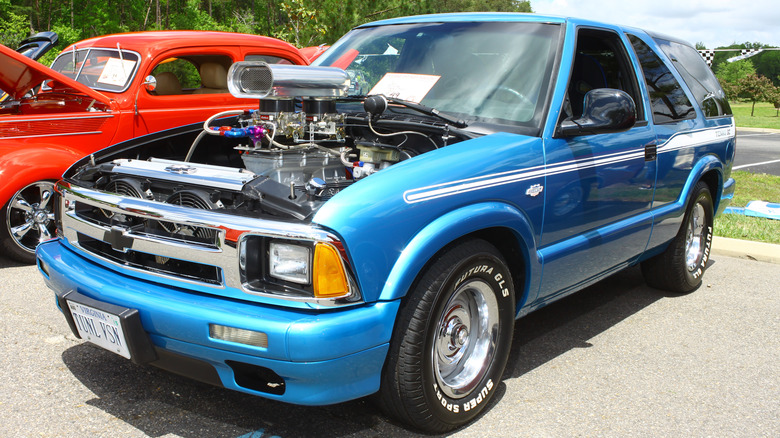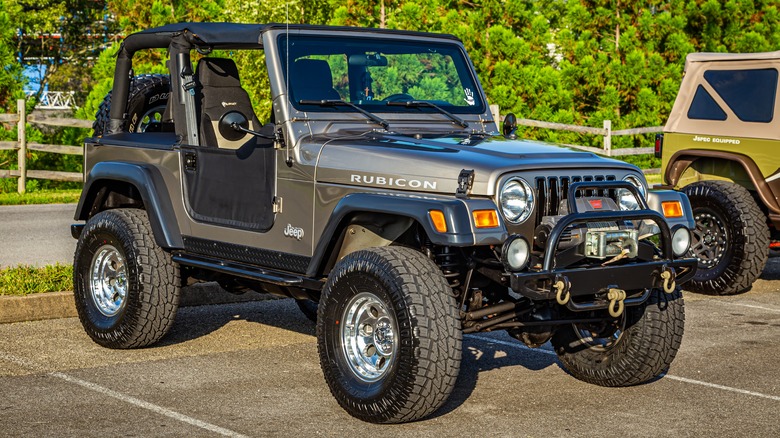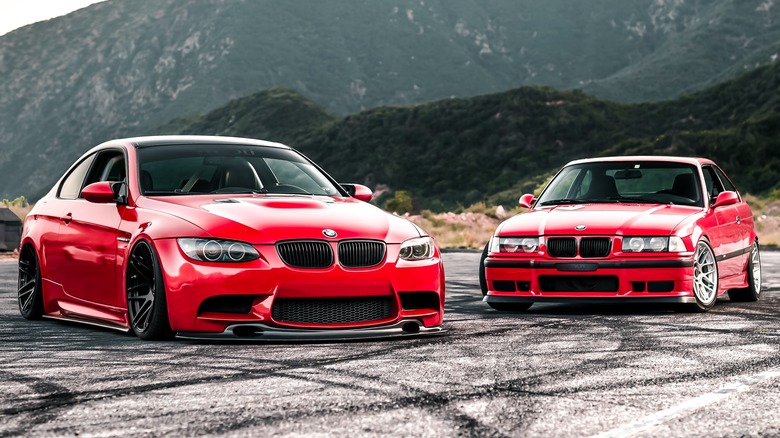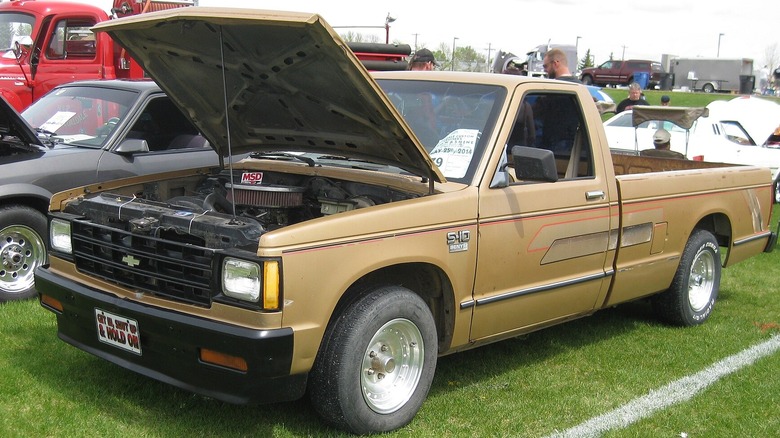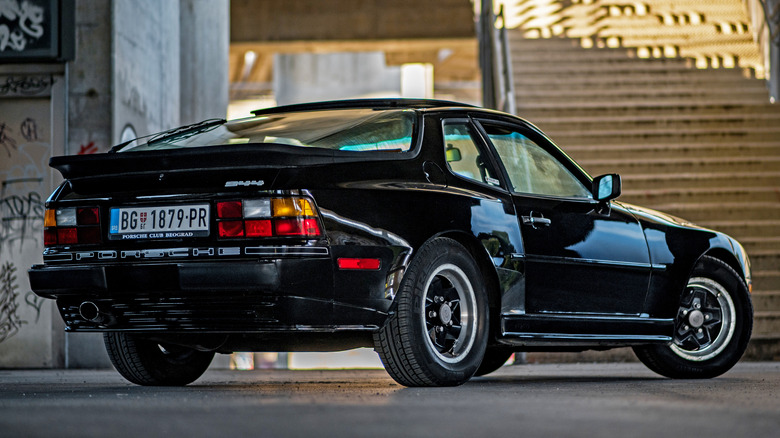The 5 Cars That Are Perfect For A V8 Engine Swap
With prices of classic muscle cars like the Dodge Charger or Chevy's Chevelle SS heading for the stratosphere, a common way to cobble your own together on the cheap is to purchase a lowly six-cylinder version of the same car and swap in a small-block or big-block V8 engine. That said, V8 conversions aren't the sole domain of 1960s and 1970s muscle cars. Especially nowadays with the widespread junkyard availability of Chevrolet's epic LS-series engine, we're seeing all sorts of vehicles — foreign and domestic — refitted with thundering American V8s.
The reasoning can be as simple as increasing horsepower less expensively, or going beyond modifying the vehicle's original motor. Perhaps the original engine met its demise and a V8 transplant is a more economical method to get back on the road compared to repairing or replacing foreign machinery. It's often a more reliable alternative, too.
Aside from the usual suspects, which are vehicles that had V8s available from the factory, let's take a peak at some less conventional swap candidates that are nonetheless the perfect platform for a V8 powerplant.
1987-2006 Jeep Wrangler
Until recently, you couldn't buy Jeep's iconic Wrangler off-road SUV with a V8 engine. Even now, the choice is limited to the brand's Rubicon 392 (its Hemi V8 engine displaces 392 cubic inches), which retails for a wallet-busting $89,390, and can easily eclipse $100k if the buyer checks all of the boxes for optional extras. That's too bad, because when a Jeep is fitted with heavy aftermarket equipment like winches, cargo racks, rooftop tents, or larger diameter tires, the engine can quickly become underpowered.
Fortunately, there is tremendous aftermarket support for replacing that anemic four or six-cylinder in a Jeep with the V8 of your choice. If you're considering the swap, the 1987 to 2006 Wranglers — which comprise the YJ and TJ generations of Wranglers — are among the easier and least expensive starting points.
Companies like Advanced Adapters offer complete kits for the swap, which include motor mounts, transmissions adapter, and even a radiator. Prices start at approximately $1,700 for the conversion kit to small-block Chevy, not including labor or the motor itself.
1992-2005 BMW 3-Series
We know what you're thinking. It's pure sacrilege to replace some of BMW's most desirable naturally aspirated six-cylinder engines like the M54 and N52 with a motor out of a Chevy truck, but it's actually quite a popular swap. If the factory inline-6 is damaged, repair or replacement can be cost-prohibitive. Even on its best day, the BMW engine is also never going to match the power potential of a modified LS. Not to mention that some 3-series from this era had weaker four-cylinders rather than the inline-6 to begin with.
Of course, the Chevy LS is a perennial favorite for the donor motor, but Ford's overhead-cam Coyote V8 is also gaining some figurative traction in car mods. Although the 3-series wasn't exactly an inexpensive car when new, they are currently available in the used market for very reasonable prices, often for less than $5,000. Additionally, the entry level "Bimmer" was made in a wide variety of body styles including coupe, sedan, convertible, and wagon.
Several years ago, former Gas Monkey Garage staffer Aaron Kaufman did a budget build LS-swapped E36 to compete against some of the characters from Street Outlaws in their Firebird. Unfortunately, Aaron's BMW came in second place — mostly due to traction issues harnessing all the newfound horsepower — but the publicity shed additional light on this unlikely American V8 transplant.
1974-1996 Jaguar XJ6, XJ12 and XJS
Like the BMW above, the merging of a steadfast English luxury car with a rambunctious Chevy or Ford V8 engine is an unlikely pairing, but it's one that's often undertaken to extend the lives of Jaguar's iconic sedan or swoopy coupe. Taking the insanity one step further, several builders have even fitted their V8-swapped Jaguars with a giant roots-style supercharger poking out of a hole in the bonnet — er, hood.
One of the more notorious examples is a 1974 XJ12 with a transplanted supercharged small-block Chevy that's owned by the MotorTrend show "Roadkill." Nicknamed the "Draguar," this wild creation has logged standing quarter-mile times in the 12-second range, which is about the same as a brand-new Camaro SS.
According to the company John's Cars in Texas — which operates a website called brokenkitty.com, and details the process of V8 swapping old Jaguars — one of the top reasons for the American V8 swap is reliability. Older English cars have a reputation for being temperamental. When the time does come to repair your Jag, parts for a Chevy engine are cheap and plentiful. While you could justify the V8 swap with practicality, the increased power is certainly an added benefit, especially with modifications.
John's Cars sells conversion kits for small and big block Chevy V8s ranging from $845 to $1,875 depending on the level of completeness. Of course, that doesn't include the donor engine itself, nor the labor to install.
1982-2004 Chevrolet S-10
One of the most popular and least expensive V8 swaps on this list, stuffing a small-block Chevy into your S-10 can turn the compact pickup into a drag strip hero. There are also plenty of milder daily driver versions, too. Since many Chevrolet S-10s came equipped with a 4.3 liter V6 engine that's essentially a 350 cubic inch V8, minus two cylinders, the conversion is as simple as it gets.
Even if your truck has an engine other than the 4.3 liter V6, the aftermarket is overflowing with kits to help, with speed parts merchants such as Summit and Jegs selling complete swap kits for less than $800. These sets include engine mounts, a set of tubular exhaust manifolds (a.k.a. headers), a rear-sump oil pan to fit the S-10's chassis, all hardware and gaskets, and a comprehensive set of instructions for installation as well.
Since the little S-10 pickup is a corporate twin of the GMC S-15, the conversion kits fit that truck as well. Additionally, the S-10 Blazer SUV and its GMC counterpart — the S-15 Jimmy — are also fair game for the V8 swap since these vehicles share virtually the same underpinnings as the pickup trucks. Whether hauling cargo or passengers, a new V8 allows you to do so more quickly.
[Featured image by dave_7 via Wikimedia Commons | Cropped and scaled | CC BY 2.0]
1983-1991 Porsche 944
When new, the 944 was marketed as the entry-level Porsche, and the least expensive path to get yourself into the brand. 40 years later, in the secondary market, the same mantra largely still applies. Though to be fair, collectors have now discovered the 944, and it's no longer the bargain it once was. According to the valuation site classic.com, the average selling price for a base model 944 over the past twelve months is $13,310, but careful shoppers can still find less-than-pristine examples in the $5,000 range.
The 944 has always been praised for its balanced handling and weight distribution, with a rear-mounted transaxle connected to the engine via a "torque tube," which is Porsche-speak for a robust, vibration-free driveshaft that it licensed from Mitsubishi, of all sources.
Universally, the 944 was factory equipped with a compact inline four-cylinder engine that pushed it from 0-60 MPH in a leisurely 8.5 seconds. While some later models were available with four valves per cylinder (16V) and/or turbocharging, even that output was no match for a modern LS, never mind one with customization.
If you need another excuse to replace the factory Porsche engine, it was equipped with a consumable rubber timing belt that can grenade the entire engine if it fails. Some might criticize that the large V8 will upset the perfect distribution, but if you can splurge for an aluminum LS engine as opposed to an iron block, the weight gain over the Porsche four-cylinder is only 25-30 pounds.
